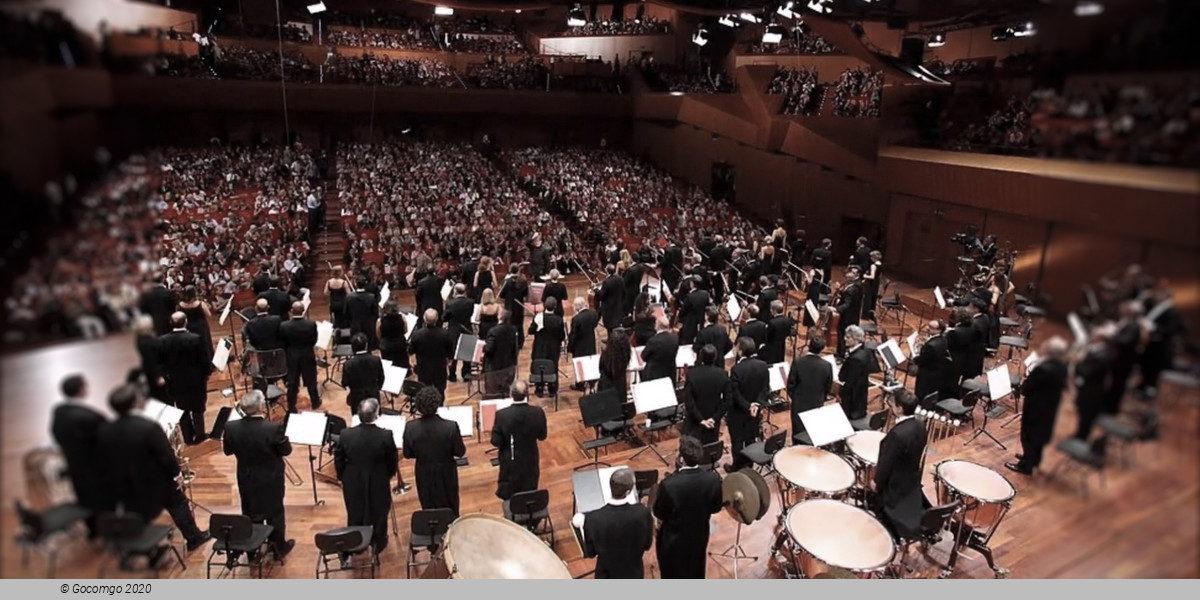Auditorium Parco della Musica (Sala Santa Cecilia) (Rome, Italy)
Auditorium Parco della Musica (Sala Santa Cecilia)

Designed by Renzo Piano and operated by the Musica per Roma Foundation, the Auditorium Parco della Musica Ennio Morricone, created to give the National Academy of Santa Cecilia a permanent home, has become in recent years one of the largest cultural and performing arts centre in Europe, holding events that include all musical genres as well as dance, theatre and even art exhibits.
This exceptional structure, with its sophisticated architecture, is the most important urban-renewal and cultural project carried out in Rome since the 1960s, sitting just a few minutes’ drive from the city’s historic centre, in an area bounded by the Tiber river, the hill of the Parioli neighbourhood and the Olympic Village quarter. The large, multipurpose complex meets the needs of a range of different audiences, combining quality and show business, culture and fun.
Tracing the site’s history involves going back to 1936, when Mussolini, in order to unearth the remains of the ancient roman Mausoleum of Augustus, ordered the demolition of the Augusteo , the splendid concert hall in which the orchestra and the chorus of the Accademia Nazionale di Santa Cecilia had been performing since 1908.
Once the Augusteo was gone, the project of building an auditorium meeting international standards of quality was addressed by the various city governments elected over the years, as well as by leading musical and cultural figures, including Giuseppe Sinopoli and Vittorio Emiliani, both of whom long championed the need to endow the Eternal City with a facility devoted to music.
In 1993, the City of Rome held an international competition for proposals, establishing the site of the new auditorium in a space found between the Olympic Village Quarter and the Flaminio Stadium. The goal, in this deteriorated, semi-abandoned area along the Via Flaminia, just a few kilometres from the heart of the city, was to mend a torn portion of the city’s fabric.
On 27 July 1994, it was announced that Renzo Piano and the Renzo Piano Building Workshop had presented the winning proposal, and on 15 January 1995 the project was officially initiated by the City of Rome. The work was interrupted in November of that year, when the remains of an ancient Roman villa came to light, though, following modifications in the original plans, the ruins were made a part of the complex. Construction was completed on one of the parking facilities in the winter of 1998, but a series of problems involving the companies that had won the original contract tender led the city, between 1999 and 2000, to reassign the work to other, more efficient firms, which moved forward more rapidly. Meanwhile, in 1999, the city founded the management company Musica per Roma MpR S.p.A, which was transformed into a foundation in 2004, with responsibility for tasks of administration and organisation, plus cultural planning and production.
On 21 April 2002, the Petrassi and Sinopoli concert halls were unveiled, while the Santa Cecilia hall was opened later in the same year, on 21 December. The rest of the complex was completed in early 2003, when it began operating at full capacity. Following the passing of Ennio Morricone in 2020, the Auditorium was named after the great maestro.
With its 2,744 seats, the Sala Santa Cecilia is one of the largest concert halls in Europe. It is designed for symphonic music, large orchestras and large choirs. Since it was built in 2002, the Auditorium has hosted the most prestigious names in jazz, rock and pop music.
The architectural features of the Sala Santa Cecilia give it a great visual impact, which is why it is requested by the most important multinational businesses as a venue for prestigious conferences. Particularly suitable for official ceremonies, this hall is perfect for hosting all high-profile events. The stage is positioned almost centrally, surrounded by seats set on cantilevered galleries that extend around the orchestra, allowing the speaker the opportunity to communicate in 360 degrees. The real conceptual innovation of the Sala Santa Cecilia is the suspended ceiling, which is made up of 26 cherry wood shells, covering a total area of over 4,000 square metres. The wood also covers the stalls and part of the galleries, providing exceptional acoustics, which can be adjusted using fabric curtains around the entire perimeter of the hall.


